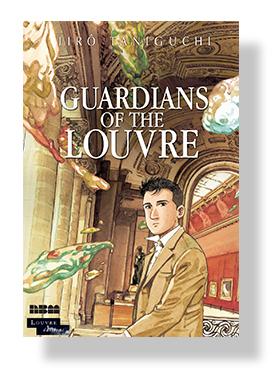Whew–it’s been a while! Life got in the way of blogging for a few months, but the summer forecast looks good for manga reviewing. On the docket this week: Jiro Taniguchi’s Guardians of the Louvre, part of an ongoing graphic novel series published by NBM/Comics Lit that also includes Glacial Period, On the Odd Hours, and Rohan at the Louvre.
 Guardians of the Louvre
Guardians of the Louvre
By Jiro Taniguchi
No rating
NBM Graphic Novels, $24.99
One part Times of Botchan, one part Night at the Museum, Jiro Taniguchi’s Guardians of the Louvre is a stately, handsomely illustrated manga that never quite rises to the level of greatness.
The premise is simple: a Japanese artist lies ill in his Parisian hotel room, feverishly dreaming about the museum’s galleries. In each chapter, the hero is temporarily transported to a particular place and time in the Louvre’s history, rubbing shoulders with famous artists, witnessing famous events, and chatting with one of the museum’s most famous works–the Nike of Samothrace, who takes the form of a stone-faced tour guide. If the set-up sounds like The Times of Botchan, it is, though Guardians of the Louvre is less ambitious; Taniguchi’s primary objective is to celebrate the museum’s collection by highlighting a few of its most beloved works, rather than immersing the reader in a specific milieu.
The artist-as-time-traveler schtick is a little hackneyed, but provides Taniguchi with a nifty excuse to showcase the breadth of his artistry, offering the reader a visual feast of rural landscapes, gracious country manors, war-ravaged cities, and busy galleries. Using watercolor and ink, Taniguchi convincingly recreates iconic paintings by Van Gogh and Corot, effortlessly slipping into each artist’s style without slavishly reproducing every detail of the originals. Taniguchi’s characters are rendered with a similar degree of meticulousness, though their waxen facial expressions sometimes mar scenes calling for a meaningful display of emotion.
What prevents Guardians of the Louvre from taking flight is its relentlessly middlebrow sensibility. In one scene, for example, the Nike of Samothrace leads our unnamed hero through an empty Salle des États, home of the Mona Lisa. The artist examines the painting closely, musing about the tourist hordes that normally throng the gallery. “It’s not about art appreciation anymore. It’s wholly a popular tourist destination” he says wistfully. If his character was anything more than an audience surrogate, his comment might have registered as a thoughtful meditation on the commercialization of fine art, or the outsized fame of Da Vinci’s canvas. Absent any knowledge of who he is or what kind of art he creates, however, his remarks sounds more like a moment of bourgeois snobbery: don’t these peasants realize the Louvre is filled with other remarkable paintings?
A similarly pedestrian spirit animates the chapters documenting the 1939 evacuation of the Louvre. To be sure, the mechanics of packing and transporting the art are fascinating; Taniguchi’s expert draftsmanship conveys the complexity and physical demands of the task in vivid detail, inviting us to ride along with Delacroix’s monumental Raft of the Medusa on its perilous journey from Paris to Versailles. The dialogue that frames these passages, however, is rife with cliches. “They were ready to risk everything to evacuate the paintings,” the Nike solemnly informs our hero before implying that this operation was a little-known episode in French history–a strange claim, given the story’s romantic treatment in popular culture: surely the Nike has read All the Light We Cannot See or watched The Monuments Men?
The manga’s most effective passages, by contrast, are wordless. We see our hero wander through a forest where Corot silently paints the undulating boughs, and a medieval town where Van Gogh sets up his easel in a sun-drenched hay field. In these fleeting moments, Taniguchi’s sensual imagery allows us to step into the artist’s shoes and relive the creative process that yielded Recollection of Mortefontaine and Daubigny’s Garden for ourselves. If only the rest of the manga wasn’t so insistent on telling us how to appreciate these paintings.
Reviews: Sean Gaffney gives Rokudenashiko’s autobiographical manga What Is Obscenity? the thumbs-up. Over at The Fandom Post, Matthew Alexander jumps in the WABAC Machine for a look at Shaman Warrior, one of the first manhwa published by Dark Horse.
- Julie on Abby and the Playboy Prince (Manga Maniac Cafe)
- Helen on A Centaur’s Life (The OASG)
- Megan R. on Earthian (The Manga Test Drive)
- Frank Inglese on vol. 10 of Food Wars!! Shokugeki no Soma (Snap 30)
- Richard Prenice on vol. 11 of Food Wars!! Shokugeki no Soma (Three if By Space)
- Matt on vol. 2 of Forget Me Not (Ani-TAY)
- Seth Hahne on A Girl on the Shore (Good OK Bad)
- Michael Burns on vol. 2 of Handa-kun (Ani-TAY)
- Matthew Alexander on vol. 1 of He Is My Master (The Fandom Post)
- Infinitespeech on vol. 1 of I Am a Hero (The Fandom Post)
- Kory Cerjak on vol. 3 of JoJo’s Bizarre Adventure, Part 2: Battle Tendency (The Fandom Post)
- Nick Creamer on vol. 4 of My Hero Academia (Anime News Network)
- Nick Creamer on vol. 1 of Mysterious Girlfriend X (Anime News Network)
- Chris Beveridge on vol. 2 of Nichijou (The Fandom Post)
- Dustin Cabeal on vols. 13-15 of Nisekoi: False Love (Comic Bastards)
- Dustin Cabeal on vol. 1 of Prison School (Comic Bastards)
- Kristin on vol. 1 of Shuriken and Pleats (Comic Attack)
- Frank Inglese on vol. 5 of Tokyo Ghoul (Snap 30)
- Robert Prentice on vol. 6 of Tokyo Ghoul (Three If By Space)
- Julie on Wife by Contract, Mistress on Demand (Manga Maniac Cafe)
- Frank Inglese on vol. 9 of World Trigger (Snap 30)
- ebookgirl on vol. 11 of Yotsuba&! (Geek Lit Etc.)